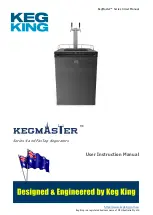
68
User's Guide Digiface Ravenna
© RME
25.2 MADI Basics
MADI, the serial
M
ultichannel
A
udio
D
igital
I
nterface, has been defined already in 1989 as an
extension of the existing AES3 standard following several manufacturers' wish. The format also
known as AES/EBU, a balanced bi-phase signal, is limited to two channels. Simply put, MADI
contains 28 of those AES/EBU signals in serial, i. e. after one another, and the sample rate can
still even vary by +/-12.5%. The limit which cannot be exceeded is a data rate of 100 Mbit/s.
Because an exact sampling frequency is used in most cases, the 64 channel mode was intro-
duced officially in 2001. It allows for a maximum sample rate of 48 kHz + ca. 1%, corresponding
to 32 channels at 96 kHz, without exceeding the maximum data rate of 100 Mbit/s. The effective
data rate of the port is 125 Mbit/s due to additional coding.
Older devices understand and generate only the 56 channel format. Newer devices often work in
the 64 channel format, but offer still no more than 56 audio channels. The rest is being eaten up
by control commands for mixer settings etc.
For the transmission of the MADI signal, proved methods known from network technology were
applied. Most people know unbalanced (coaxial) cables with 75 Ohms BNC plugs, they are not
expensive and easy to get. The optical interface is much more interesting due to its complete
galvanic separation, but for many users it is a mystery and quite expensive
With MADI, sample multiplexing is often used as well to offer sample rates higher than 48 kHz.
The MADIface supports all formats. 96 kHz can be received and transmitted both as 48K Frame
(using S/MUX) and as native 96K Frame. In 48K Frame Double Speed mode, the MADIface dis-
tributes the data of one channel to two consecutive MADI channels. This reduces the available
channel count from 64 to 32.
As the transmission of double rate signals with 48K Frame is done at standard sample rate (Single
Speed), the MADI ports still operate at 44.1 kHz or 48 kHz.
In fact, technical reasons require to use this method beyond 96 kHz. A 192K or 384K Frame
format would not be fully compatible to the MADI standard. Therefore 192 kHz is supported as
S/MUX4 only. So in 48K Frame Quad Speed mode, a MADI device distributes the data of one
channel to four consecutive MADI channels. This reduces the available channel count from 64 to
16.
As the transmission of quad rate signals with 48K Frame is done at standard sample rate (Single
Speed), the MADI ports still operate at 44.1 kHz or 48 kHz.
25.3 Terminology
Single Speed
Sample rate range originally used in Digital Audio. Typical applications are 32 kHz (digital radio
broadcast), 44.1 kHz (CD), and 48 kHz (DAT).
Double Speed
Doubles the original sample rate range, in order to achieve higher audio quality and improved
audio processing. 64 kHz is practically never used, 88.2 kHz is quite rare in spite of certain ad-
vantages. 96 kHz is a common format. Sometimes called
Double Fast
.
Quad Speed
Controversially discussed way of ensuring hi-end audio quality and processing by quadrupling
the sample frequency. 128 kHz is non-existent, 176.4 kHz is rare, if at all then 192 kHz is used,
e.g. for DVD Audio.
Содержание Digiface Ravenna
Страница 5: ...User s Guide Digiface Ravenna RME 5 User s Guide Digiface Ravenna General...
Страница 9: ...User s Guide Digiface Ravenna RME 9 User s Guide Digiface Ravenna Installation and Operation Windows...
Страница 23: ...User s Guide Digiface Ravenna RME 23 User s Guide Digiface Ravenna Mac OS X Installation and Operation...
Страница 31: ...User s Guide Digiface Ravenna RME 31 User s Guide Digiface Ravenna TotalMix FX...
Страница 33: ...User s Guide Digiface Ravenna RME 33...
Страница 63: ...User s Guide Digiface Ravenna RME 63 User s Guide Digiface Ravenna Technical Reference...
Страница 70: ...70 User s Guide Digiface Ravenna RME...
Страница 71: ...User s Guide Digiface Ravenna RME 71 User s Guide Digiface Ravenna Miscellaneous...






































